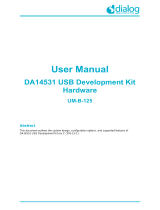Figures
Figure 1: DA14695 USB Kit ................................................................................................................... 5
Figure 2: DA14695 USB Kit - Top Side ................................................................................................. 6
Figure 3: DA14695 USB Kit - Bottom Side ............................................................................................ 7
Figure 4: Test Points Topology (BOTTOM View) .................................................................................. 9
Figure 5: Block Diagram of DA14695 USB Kit .................................................................................... 10
Figure 6: DA14695 Schematic ............................................................................................................ 12
Figure 7: RF Matching Circuit, Printed Antenna, and SMA Connector ............................................... 17
Figure 8: RF Port, RF Connector, RF Matching, and SMD Chip Antenna .......................................... 17
Figure 9: QSPI Data Flash .................................................................................................................. 18
Figure 10: Available packages for QSPI Data Flash ........................................................................... 18
Figure 11: Reset Circuit ....................................................................................................................... 19
Figure 12: RESET Push Button (K2) ................................................................................................... 19
Figure 13: General Purpose Push Button ........................................................................................... 19
Figure 14: General Purpose Push Button K1 (Populated at TOP) ...................................................... 20
Figure 15: Debugging DIP Switch ....................................................................................................... 20
Figure 16: Debugging DIP switch ........................................................................................................ 20
Figure 17: General Purpose Red LED ................................................................................................ 21
Figure 18: General Purpose Red LED D7 ........................................................................................... 21
Figure 19: Mikrobus™ Pin Assignment ............................................................................................... 21
Figure 20: J15, J16, J17, and J18 Female Sockets (Must Be Soldered by Users)............................. 22
Figure 21: Guides for Proper Mikrobus™ Click Boards Insertion ....................................................... 22
Figure 22: Mikrobus™ Pin Assignment ............................................................................................... 22
Figure 23: GND Support Point ............................................................................................................ 23
Figure 24: GND Support Point (Must Be Placed by Users) ................................................................ 23
Figure 25: Over Voltage Protection Circuit .......................................................................................... 23
Figure 26: Over Current Protection Circuit on V30 Power Rail ........................................................... 24
Figure 27: USB HUB Circuitry ............................................................................................................. 24
Figure 28: Debugging Processor UART And JTAG Interface (U4) ..................................................... 25
Figure 29: DA14695 USB Kit Power Tree ........................................................................................... 26
Figure 30: Linear Voltage Regulators (LDOs) U2 And U3 .................................................................. 26
Figure 31: PCB Cross Section ............................................................................................................ 28
Figure 32: DA14695 SoC Section ....................................................................................................... 29
Figure 33: UART & JTAG Interface Chip Section ............................................................................... 30
Figure 34: USB Hub Section ............................................................................................................... 31
Figure 35: Bill of Materials (BOM) ....................................................................................................... 32
Tables
Table 1: Test Points Assignment ........................................................................................................... 8
Table 2: USB Kit Pin Assignment ........................................................................................................ 14
Table 3: Y1 (32 MHz crystal) characteristics ....................................................................................... 16
Table 4: Y2 (32.768 kHz crystal) characteristics ................................................................................. 16
Table 5: RF Components Names and Values ..................................................................................... 17
Table 6: DA14695 power configurations ............................................................................................. 27





















